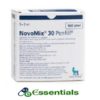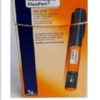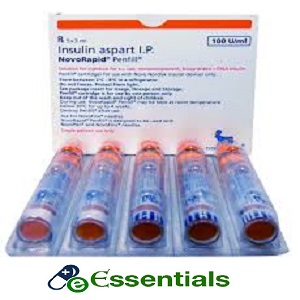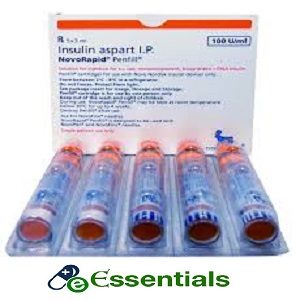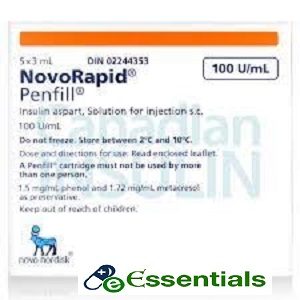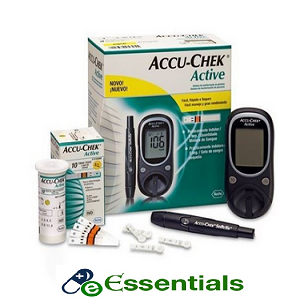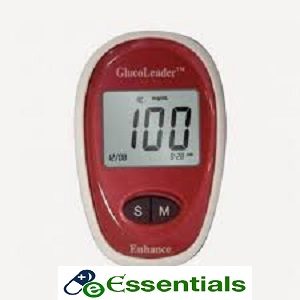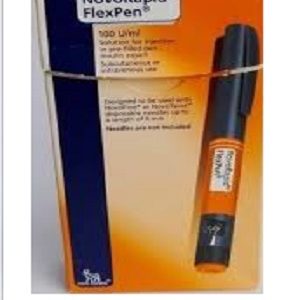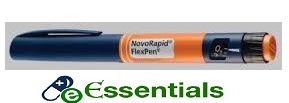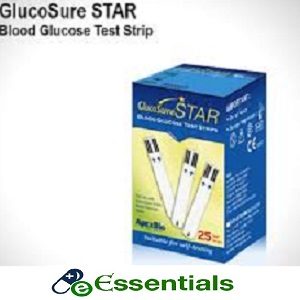Novorapid Penfill 1 pcs
৳ 730.00
Brand Name : Novorapid Penflex
Manufacturer : Novonordisk
Composition
Indications
Protamine Crystallised Insulin Aspart is an insulin analog indicated to improve glycemic control in patients with diabetes mellitus.
Therapeutic Class
Description
Dosage
Insulin Aspart has a faster onset and a shorter duration of action than soluble human insulin. Due to the faster onset of action, Insulin Aspart should generally be given immediately before a meal. When necessary Insulin Aspart may be given soon after a meal.
Dosage of Insulin Aspart is individual and determined on the basis of the physician’s advice in accordance with the needs of the patient. It should normally be used in combination with long-acting insulin given at least once a day.
The individual insulin requirement is usually between 0.5 and 1.0 IU/kg/day in adults and children over 2 years of age. In a meal-related treatment 50-70% of this requirement may be provided by Insulin Aspart and the remainder by long-acting insulin. Adjustment of dosage may also be necessary if patients undertake increased physical activity or change their usual diet. Exercise taken immediately after a meal may increase the risk of hypoglycaemia.
Subcutaneous Injection: Insulin Aspart should be administered by subcutaneous injection in the abdominal region, buttocks, thigh, or upper arm. Because Insulin Aspart has a more rapid onset and a shorter duration of activity than human regular insulin, it should be injected immediately (within 5-10 minutes) before a meal Continuous Subcutaneous Insulin Infusion (CSII) by External Pump Insulin Aspart can also be infused subcutaneously by an external insulin pump. The initial programming of the external insulin infusion pump should be based on the total daily insulin dose of the previous regimen. Approximately 50% of the total dose is usually given as meal-related boluses of Insulin Aspart and the remainder is given as a basal infusion. When used with an infusion pump Insulin Aspart should not be mixed with any other insulin.
Intravenous Use: Insulin Aspart can be administered intravenously under medical supervision for glycemic control with close monitoring of blood glucose and potassium levels to avoid hypoglycemia and hypokalemia. For intravenous use, Insulin Aspart should be used at concentrations from 0.05 IU/mL to 1.0 IU/mL insulin aspart in infusion systems using polypropylene infusion bags. Insulin Aspart has been shown to be stable in infusion fluids such as 0.9% sodium chloride.
Administration
Instructions to be given to the patient before injecting this Insulin:
- According to the instruction given with ConviPen, insert the cartridge into the pen correctly & equip the needle
- Gently turn the pen upside down for 8-10 times until the insulin in the cartridge becomes uniformly mixed suspension
- Remove the needle cap, discharge air bubbles in the catridge
- Adjust the dosage button to get correct dose & inject to the specific site
- In order to avoid cross contamination, do not let the needle touch anything during the process of preparation.
Interaction
A number of drugs affect glucose metabolism and may require dose adjustment.
The following substances may reduce the Insulin as well as Insulin Aspart requirements: Oral anti-diabetic products, angiotensin converting enzyme (ACE) inhibitors, disopyramide, fibrates, fluoxetine, monoamine oxidase inhibitors, propoxyphene, pentoxifylline, salicylates and sulfonamide antibiotics.
The following substances may increase the Insulin as well as Insulin Aspart requirements: Thiazides, glucocorticoids, thyroid hormones, beta-sympathomimetics, growth hormone and danazol. Beta-blockers, clonidine, lithium salts, and alcohol may either potentiate or weaken the blood glucose lowering effect of insulin.
Side Effects
Pregnancy & Lactation
Precautions
Overdose Effects
Storage Conditions
Brand
Novonordisk

Related products
Blood Glucose Monitors
Blood Glucose Monitors

